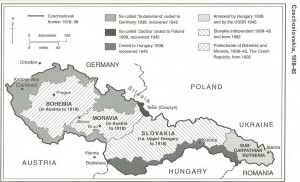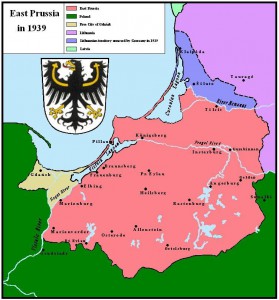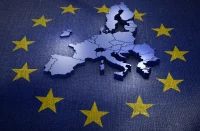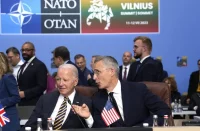And now let us take another look at the dates and events of that stormy March of 1939, in order to firmly establish that Hitler really was suddenly recast as an “aggressor,” not because he took over the defenseless country of Czechoslovakia, but because he did so in a manner completely at odds with what had been negotiated with the representatives of the West.
March 14, 1939. Slovakia declares its independence and requests protection. Czech President Emil Hácha comes to Berlin of his own accord.
March 15, 1939. President Hácha signs an agreement to incorporate the Czech lands into the Third Reich under the name of the Protectorate of Bohemia and Moravia, and thus preserves his position as head of the country. At 6:00 am, with no official announcement, Hungarian army units begin their occupation of Sub-Carpathian region.
The British government had been given explicit information about the upcoming events four days earlier. Therefore, Great Britain reacted to the “aggressor’s” moves in a very calm and friendly way, as heard in Prime Minister Chamberlain’s speech: “ …the Slovak Diet declared the independence of Slovakia. The effect of this declaration put an end by internal disruption to the State whose frontiers we had proposed to guarantee … and His Majesty’s Government cannot accordingly hold themselves any longer bound by this obligation.”In other words, there had been no breach of the Munich Agreement. Czechoslovakia had disintegrated on its own…
On the same day, the British ambassador, Nevile Henderson, sent a note to the German government: “His Majesty’s Government have no desire to interfere unnecessarily in a matter with which other Governments may be more directly concerned …”[1]
England is not expressing displeasure, but attempting to maintain a facade of respectability by hiding behind a profusion of flowery phrases. This means that for now everything is proceeding in accordance with the prearranged script.
March 16, 1939. Hitler responds to the Slovaks’ request to be taken under his protection, but does not yet sign a treaty with them. An atmosphere of uncertainty reigns, as if the key issues for Western diplomats – the incorporation of Slovakia and Sub-Carpathian Ruthenia – are shrouded in fog.
March 17, 1939. In a special note, the German government proclaims to the world the establishment of the Protectorate of Bohemia and Moravia. The fog veiling Germany’s actions began to dissipate – Hitler has only annexed the Czech lands. Slovakia still has no treaty with Germany, except the Fuhrer’s verbal promise to take that Slavic nation under his protection. But something strange was brewing in Sub-Carpathian Ruthenia: troops had entered and there was fighting, in addition to the Hungarian leaders’ statement about taking over the region. Carefully laid plans had obviously been derailed by these events, but at the time no full, clear picture of the situation was available. Western leaders began to worry.
It was then that the British prime minister, Neville Chamberlain, suddenly saw the light. In his speech in Birmingham, he actually retracted his own words from two days before. Both those in Great Britain and around the world (the speech was broadcast by radio) could listen as the leader of one of the great powers completely reversed course on his assessment of the disappearance of Czechoslovakia two days before.[2]
But nothing new had happened between March 15 and 17! Hitler had already taken over the Czech lands, an action in which neither the British Foreign Office, nor Chamberlain himself, had seen anything “criminal.”Two days passed, and then Chamberlain apologized for his previous “very restrained and cautious … somewhat cool and objective statement.”But then he continued in a completely different tone: “… we declared that any other question which might concern our two countries should be dealt with by the method of consultation … Does not the question inevitably arise in our minds, if it is so easy to discover good reasons for ignoring assurances so solemnly and so repeatedly given, what reliance can be placed upon any other assurances that come from the same source?”[3]

What happened during those two days that directly concerned the government of Great Britain? Did something new happen regarding the Czechs? No, that country no longer existed at the time the first placatory note was written. Had some metamorphosis occurred with Slovakia? No, she had declared her independence and had not been refused. Had the entry of Hungarian troops into Sub-Carpathia truly cast such a pall over the British-German friendship? What had Hitler done in the past two days that was so extreme that the head of the British government began to address him quite differently? FOR THE FIRST TIME Hitler was refusing to behave in the manner set out for him. Now they could not be certain that Germany would attack the USSR in the near future!
But it was still possible for Hitler to rectify the situation. He could annex Slovakia to the Reich and so doing return to the previously agreed script. Therefore, although firm notes could be heard in Chamberlain’s speech, it did not mark a real turning point. It was an admonition.
March 18, 1939. Hitler flies to Vienna to celebrate the anniversary of the Anschluss. Hungarian troops enter the capital of Sub-Carpathia, the town of Hust.
March 19, 1939. Paris and London feverishly analyze the developing situation. The French ambassador to Germany, Robert Coulondre, stated to the French foreign minister, Georges Bonnet: “After the Reich’s annexation of Bohemia and Moravia and Slovakia’s transfer to German guardianship, I would like to try to describe the situation resulting from these changes, which has dramatically altered the map of Europe, in order to determine in what areas German dynamism will expand, and to consider whether we still believe that this dynamism is directed only eastward, and to draw some practical conclusions from all this for our leaders. There is evidence that when planning operations against Bohemia and Moravia, the Nazi leaders have also contemplated that in the fairly near future they may even move farther toward the East. According to the information we have at present, there is reason to believe that the German army intended to occupy all of Slovakia and even Sub-Carpathian Ruthenia,”[4]Coulondre’s letter reads.
There is still hope that Hitler will advance eastward if he is properly brought to heel.
March 20, 1939. The US government recalls its ambassador from Berlin as a sign of protest against the dismemberment of Czechoslovakia that had taken place five (!) days before.
March 21, 1939. The Lithuanian government receives notice from Berlin that its plenipotentiaries must arrive in Berlin the next day on a special plane to sign the papers to transfer the district of Memel to Germany.[5]A refusal will lead to the use of force by the German government. Lithuania cannot fight Germany by herself, and England and France make no statements in her defense, as they try to make sense of the evolving situation.
European diplomats are clearly not about to engage in Lithuanian affairs as it is becoming clear that Hitler is going out of control. The president of the French Republic, accompanied by his foreign minister, makes an urgent trip to the British capital for an official visit. “To the French Chamberlain suggested that their two countries join Poland and the Soviet Union in a formal declaration stating that the four nations would consult immediately about steps to halt further aggression in Europe.”[6]
“The European leaders suddenly understood Hitler’s aggressive native and realized that the only way he could be stopped was not through concessions, but through strength,” or thus historians interpret the actions of the British and French politicians. But this ignores the fact that three days earlier, on March 18, the Soviet People’s Commissar for Foreign Affairs, Maxim Litvinov, had already suggested convening a European conference – in that instance to be attended by France, England, Poland, Russia, Romania, and Turkey.”The Soviet Union had made the same proposal now being offered by the UK, but at that time Chamberlain had deemed the idea “premature” and the French government did not even honor Moscow with a reply. Why did the British prime minister reject the suggestion made by the Soviet diplomats? Why did the leaders of France not even respond? Because that “aggressive” Hitler had three days ago devoured what was left of Czechoslovakia. What was the head of the British government waiting for? For German troops to “suddenly” retreat from the Czech and Slovak lands? No, Chamberlain was giving Hitler time to come to his senses. And to incorporate Sub-Carpathian Ruthenia into the Reich.

March 23, 1939. Early in the morning of March 23 (at 1:30 am), Lithuania signs an agreement consigning Memel to Germany. As a concession, the Lithuanians are provided with a free zone in that port that had been taken away from them. There was no reaction from London or Paris to this German annexation, despite the fact that England and France were the guarantors of the status of Klaipėda.
Now there was no reason to hold off on a decision regarding Slovakia. Immediately after signing the papers with Lithuania in the capital of the Reich, a “Treaty of Protection” between Berlin and Bratislava was signed. This strange torpor on the part of Hitler, who was partial to Blitzkreig-like actions, was motivated by the desire to create an uncertain situation. Hitler was so wily that Western diplomats did not know how to handle him. The German Fuhrer did not seem to be violating the agreements, but he was taking steps that were at odds with what had been arranged in London. And while the West was studying and evaluating the actions of the German chancellor, he was increasing the pressure, retaking territories Germany had lost at the end of World War I.
Having served England and France with a fait accompli, Hitler was then ready to begin the next round of negotiations with his partners. But now under the terms of a new situation and new conditions. Adolf Hitler had very substantive reasons to have faith in the success of these talks. Despite all the loud posturing about poor, unfortunate Czechoslovakia, the Bank of England gave Germany every penny of the Czech gold reserves that were being stored in London – all of six million pounds.[7]
And on May 30, 1939, the state secretary at the German foreign ministry, Ernst Freiherr von Weizsäcker, informed the Soviet charge d’affaires in Berlin, Georgy Astakhov, that there was a chance to improve Soviet-German relations. The German diplomat pointed out that by refusing to take Sub-Carpathian Ruthenia, one motive for war had been eliminated … and the USSR and Germany began moving toward the non-aggression pact so disliked by Western historiography.
ENDNOTES
[1] Shirer, William. The Rise and Fall of the Third Reich. Pg. 451
[2]The governments of all the German-occupied countries found refuge in London during WWII. And the leadership of Czechoslovakia was no exception. What is interesting, however, is the date of its “creation” in the English capital: July 1940! In other words, a mere 16 months after Czechoslovakia’s disappearance from the political map. Why did the British take so long to sanction the creation of this new government of a country that was “the victim of German aggression”? Because they were still hoping to reach an amicable agreement with Hitler and were trying once again not to anger him.Only after France signed an armistice on June 22, 1940, surrendering in the forest of Compiègne, and a very difficult period began for Great Britain, did the English find themselves in need of all their allies. Only then were accommodations, time, and money found for the new government of the Czechoslovak Republic.
[3]McSherry, James. Stalin, Hitler, and Europe: The Origins of World War II, 1933-1939.Pg. 130.
[4]Documents and Materials From the Brink of World War II (Russian edition), Moscow, 1948.Vol. 2.Pgs.49-50.
[5] The city of Memel is currently known as Klaipėda.
[6]Shirer, William. The Rise and Fall of the Third Reich. Pg. 460.
[7]Preparata, Guido Giacomo. Conjuring Hitler.How Britain and America Made the Third Reich. Pg. 242.
ORIENTAL REVIEW publishes exclusive translations of the chapters from Nikolay Starikov’s documentary research ““Who Made Hitler Attack Stalin” (St.Petersburg, 2008). The original text was subject to minor cuts by the OR editorial.
PREVIOUS EPISODES
Episode 13. Why London presented Hitler with Vienna and Prague (III)
Episode 12. Why did Britain and the United States have no desire to prevent WWII?
Episode 11. A Soviet Quarter Century (1930-1955)
Episode 10. Who Organised the Famine in the USSR in 1932-1933?
Episode 9. How the British “Liberated” Greece
Episode 7. Britain and France Planned to Assault Soviet Union in 1940
Episode 6. Leon Trotsky, Father of German Nazism
Episode 5. Who paid for World War II?
Episode 4. Who ignited First World War?
Episode 3. Assassination in Sarajevo














Pingback: Episode 14. How Adolf Hitler turned to be a “defiant aggressor” (II) | Oriental Review
So, now that he got wat he wanted from the Allies, he decided that it was time to break away with that dependance and common agenda which included from the very ouset the ulterior invasion of Bolshevik Soviet Union. He would not attack Soviet Union following their expectation, but rather attack Soviet Union following his own Haushofer-inspired geopolitical agenda, and that much sooner rather than later, for the Babarossa would be conceived already in the early 40s and its implementation would enter the details adjustment phase already before the end of this same year.